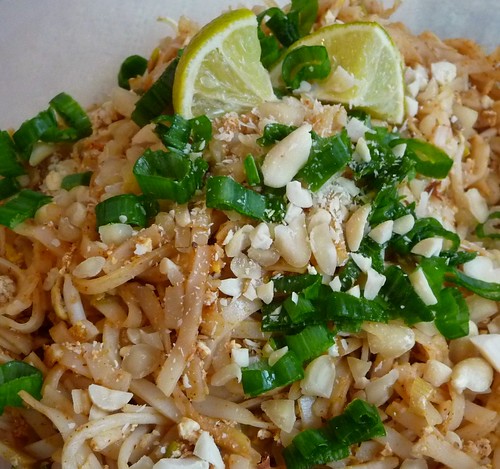My favorite was from Tup Tim Thai on lower Queen Anne. Their Pad Thai was spicy, sinfully slick with flavorful oil, and chock-full of broccoli, shrimp, tofu, eggs, bean sprouts and green onions. It was so unbelievably good, I could easily polish off an entire order in one sitting.
Since moving to rural France we've been severely deprived of Asian and Indian food. There's a serious dearth of any kind of restaurant other than French around here.
Not that we don't love the local French cuisine: tapenade, paté, duck in its many preparations, Cassoulet, goat cheese salads, brandade de morue, gigot d'agneau, etc. But variety is the spice of life and sometimes we need a little variety. And a little spice!
(and we can only spend so much time in places like Cognac and Paris trying to quench our Chinese, Vietnamese, Thai, Korean and Indian food cravings)
So I've learned to make my own versions of the take out food that we love and miss so desperately - Indian and Thai curries, Chinese food, even pizza.
Pad Thai is one dish that I've tried to make from time to time, but was never really pleased with the results. Until now.

My Pad Thai is a mélange of four different recipes that I've gleaned from cookbooks and from the Internet. It is loaded with flavor and isn't greasy, which I find many recipes for this dish are. It can be as spicy as you like and can be enjoyed with shrimp and chicken or packed full of vegetables and tofu for a fresh vegetarian version, like the one pictured above.
Pad Thai
serves 2-3 as a main course
- 8 ounces Thai rice noodles
- 8 ounces shrimp, peeled and deveined
- 4 ounces thinly sliced chicken breast
- 4 ounces firm tofu, cut into bite sized strips
- 3 tablespoons vegetable oil
- 2 garlic cloves, minced
- 1 onion, thinly sliced
- 2 eggs, lightly beaten
- 4 ounces bean sprouts
- 2 green onions, cut into 1-inch pieces
- 1/4 cup roasted, unsalted peanuts, finely chopped
- 1/3 cup fish sauce
- 1/4 cup tamarind concentrate (some brands require diluting the concentrate in water, so please read the label)
- 1/4 cup brown sugar (or 1/3 cup palm sugar)
- 2-4 teaspoons chili powder
- 2 ounces bean sprouts
- 1 lime, cut into 8 wedges
- 1/4 cup roasted, unsalted peanuts, coarsely chopped
- In a large bowl, cover the noodles with plenty of cool water and let soak for 1 hour. Drain.
- Make the sauce by bringing the sauce ingredients to a gentle simmer on the stove. Add chili powder, 1 teaspoon at a time, to get the degree of heat you like. The sauce should be tangy, with a bit of sweetness and spiciness. Adjust it to your palate.
- Heat oil in a large wok or frying pan until almost smoking. Add the onions and sauté until translucent, about 5 minutes.
- Add chicken, if using, and sauté for 1-2 minutes.
- Add garlic and tofu along with a couple of tablespoons of the sauce and the shrimp, if using, and sauté until shrimp is pink, about 2-3 minutes.
- Add the eggs and let them set for 10-15 seconds, then give them a quick stir with the other ingredients in the pan.
- Add the drained noodles and most of the sauce, and stir together. If it seems too dry, add the rest of the sauce.
- Add the bean sprouts, the green onions and the peanuts and stir everything together.
- Taste for seasoning. Sometimes I add a bit of lime juice for extra zing at this point.
- Serve with the garnish.
*A note about tamarind* (from Chez Pim)
"You can buy tamarind in blocks or readymade pulp that comes in plastic or glass containers (see the photo above). If you can't find a local market that carries tamarind you can order it online. If you buy readymade pulp, check to make sure that the ingredients only contain tamarind and water, no sugar or anything else. If you buy block tamarind, soak the block in 4 cups of hot water in a large bowl. Mesh the tamarind and water together and let sit until the water cool down enough not to burn your hands. Stick your hands -your impeccably clean hands as Julia Child would say- into the bowl and work the tamarind and water together until the consistency is a bit looser than room-temperature ketchup. Add more warm water if needed. Then, strain the mixture to remove the pits and tough membranes from the tamarind pulp. The consistency will be thick enough that you'd need to press it through the strainer. Use as much as you need for the Pad Thai sauce and keep the rest in a glass jar in your fridge. You'll have tamarind pulp handy for a long time."
No comments:
Post a Comment